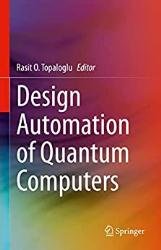 Название: Design Automation of Quantum Computers
Название: Design Automation of Quantum ComputersАвтор: Rasit O. Topaloglu
Издательство: Springer
Год: 2023
Страниц: 171
Язык: английский
Формат: pdf (true), epub
Размер: 26.3 MB
This book provides readers with a comprehensive, state-of-the-art reference to the design automation aspects of quantum computers. Given roadmaps calling for quantum computers with 2000 qubits in a few years, readers will benefit from the practical implementation aspects covered in this book. The authors discuss real hardware to the extent possible.
Quantum computers are on the cusp of having navigated the wavy roads from theory to practice. I remember vividly that a decade ago, less than a handful of qubits on hardware was boasted as the state of the art and yet generated awe in me and others. Fast forward to today, there are quantum computers that have shattered the hundred qubit ceiling and the next big mark is a thousand qubits.
Beyond hundred qubits, manual process of the design flow starts to become a bottleneck. One of the voids that this book targets is to provide means for designing quantum computers with hundred qubits or more. In the first chapter, researchers from Johannes Kepler University Linz introduce decision diagrams as a method to cope with memory limitations for simulation and verification of quantum systems. Second chapter by UCLA targets the problem of optimally mapping logical qubits to physical ones on the hardware. Third chapter from UCSB is a timely treatment of quantum processor architecture design.
Beyond the simulation, verification, and design aspects of quantum computers, there are also application aspects. In the fourth chapter, Penn State researchers utilize a quantum computer to generate random numbers, which have many applications including cryptography.
One branch of quantum technology has been focusing on exploiting superconducting device speeds while utilizing traditional digital circuit logic. This branch uses flux-based devices. In the fifth chapter, National Tsing Hua researchers develop a placement algorithm for a single-flux quantum-based field programmable gate array. The next chapter by USC authors targets yield optimization aspects of the single-flux quantum technology. The book finishes off with an exploration of the single-flux quantum technology for hardware security, in particular logic locking aspects by University of Rochester researchers.
Just like that last talk before lunch, this is the last paragraph before leaving you with appetizing and yet easy-to-digest content from top academics. Thinking back, perhaps it was that awe that motivated me to learn more about this field and make contributions. With regard to this book, it has been not only enjoyable to read their chapters but also to work with these elite authors for improvements. I anticipate the contents of this book could indeed lead the way to advance the quantum field in terms of design automation of quantum computers.
To a quantum future!
Provides an up-to-date, single-source reference to design automation aspects of quantum computers;
Presentation is not just theoretical, but substantiated with real quantum hardware;
Covers multi-faceted aspects of quantum computers, providing readers with valuable information, no matter the direction in which technology moves.
Скачать Design Automation of Quantum Computers